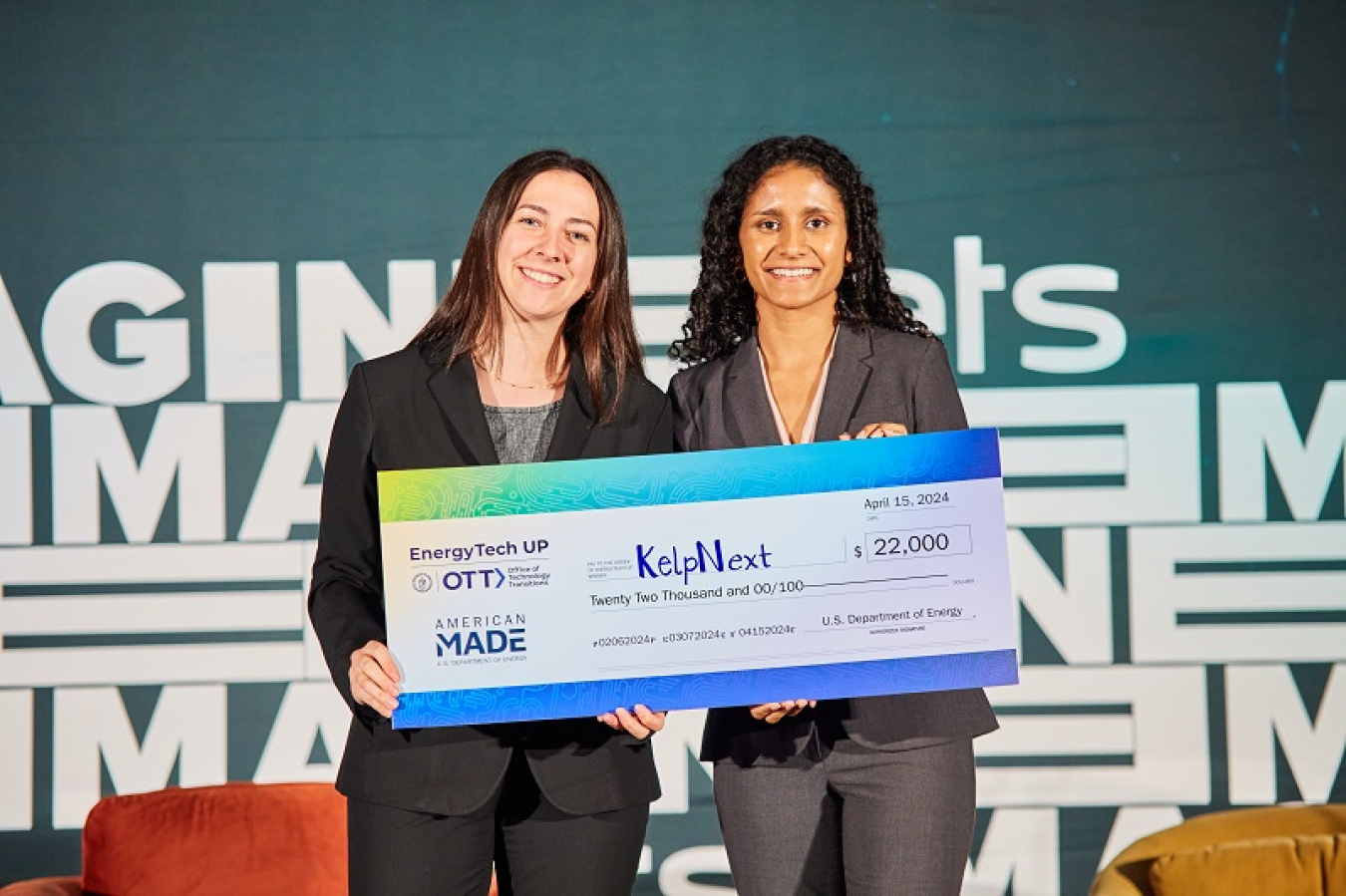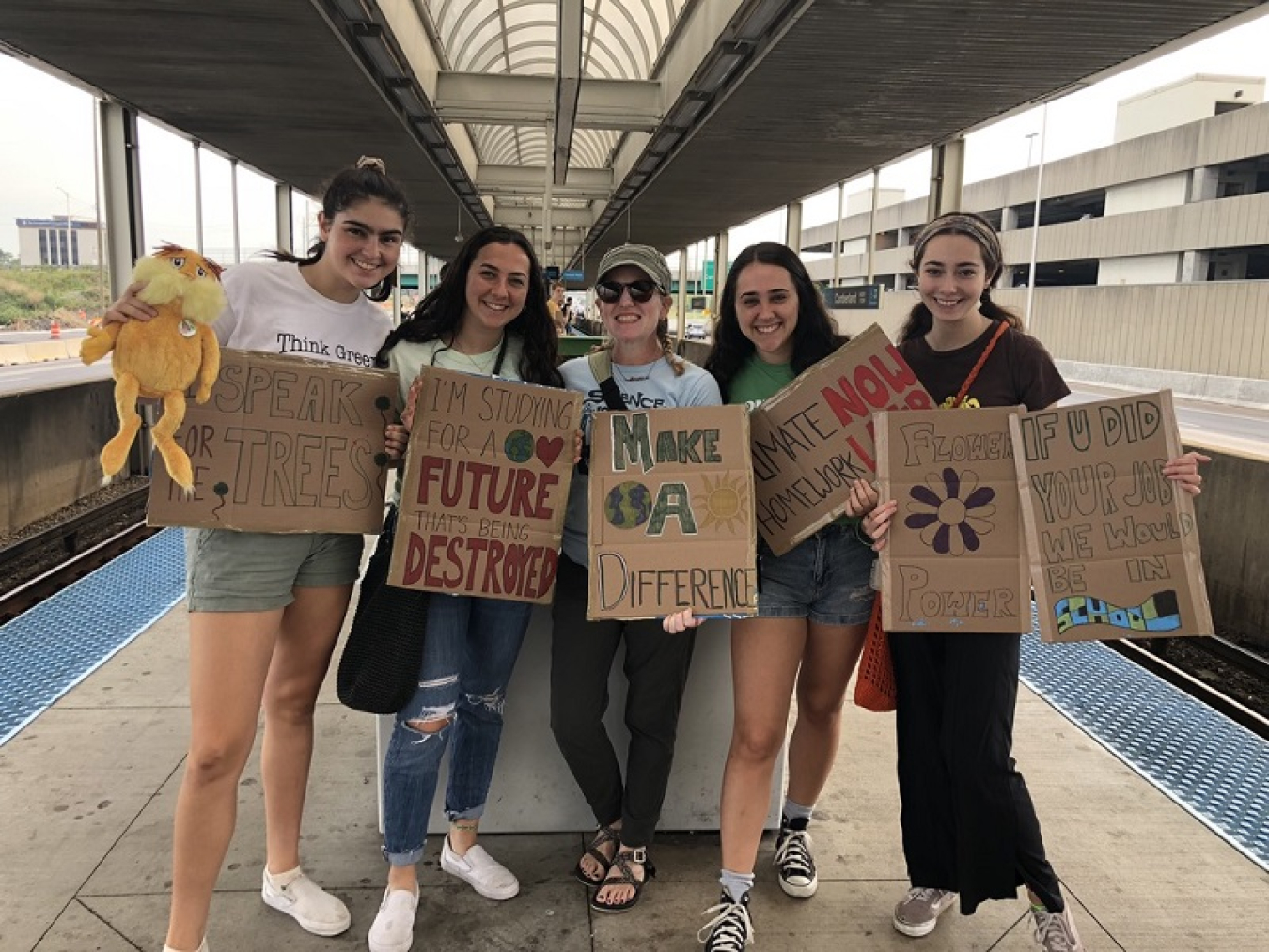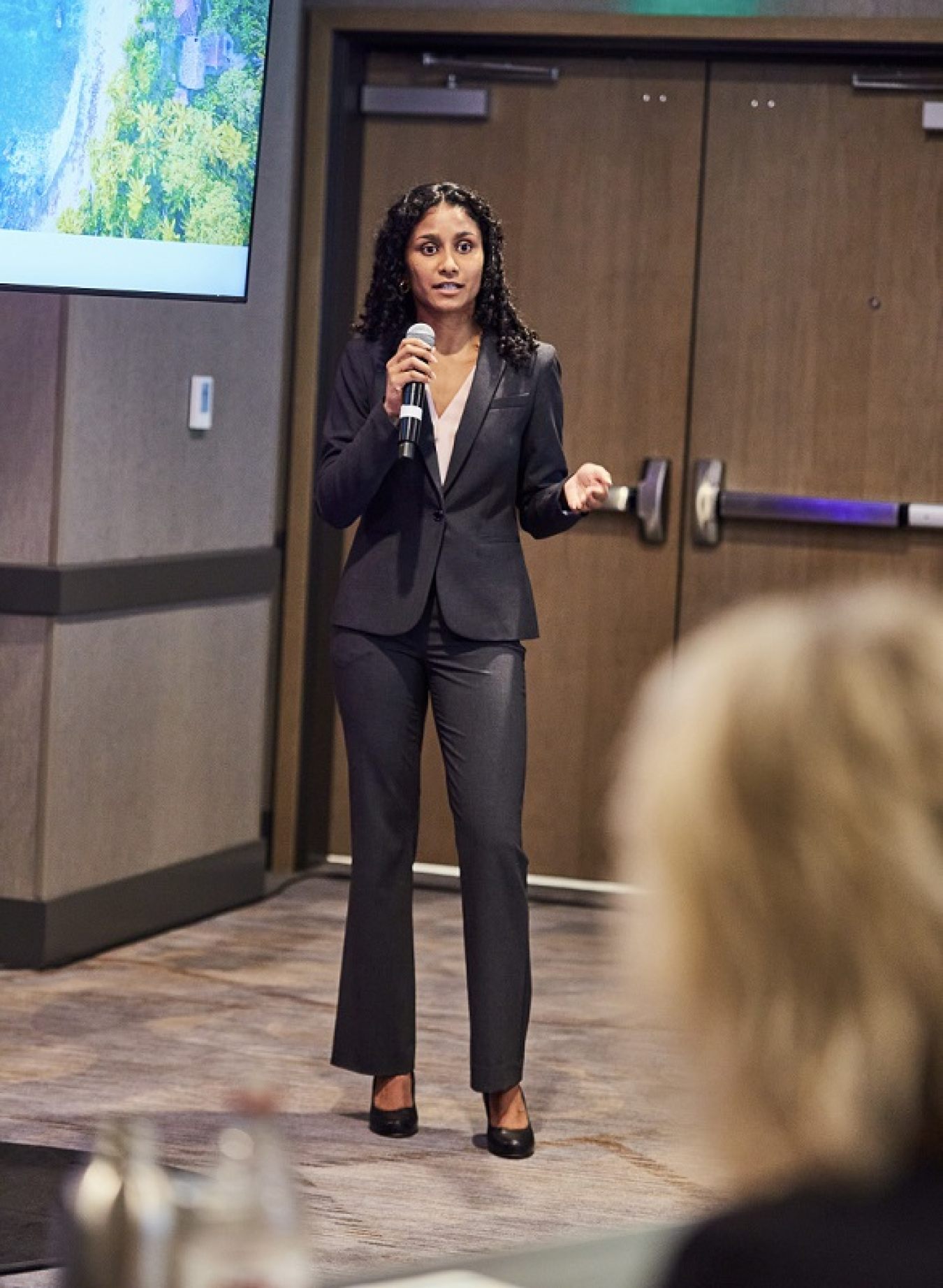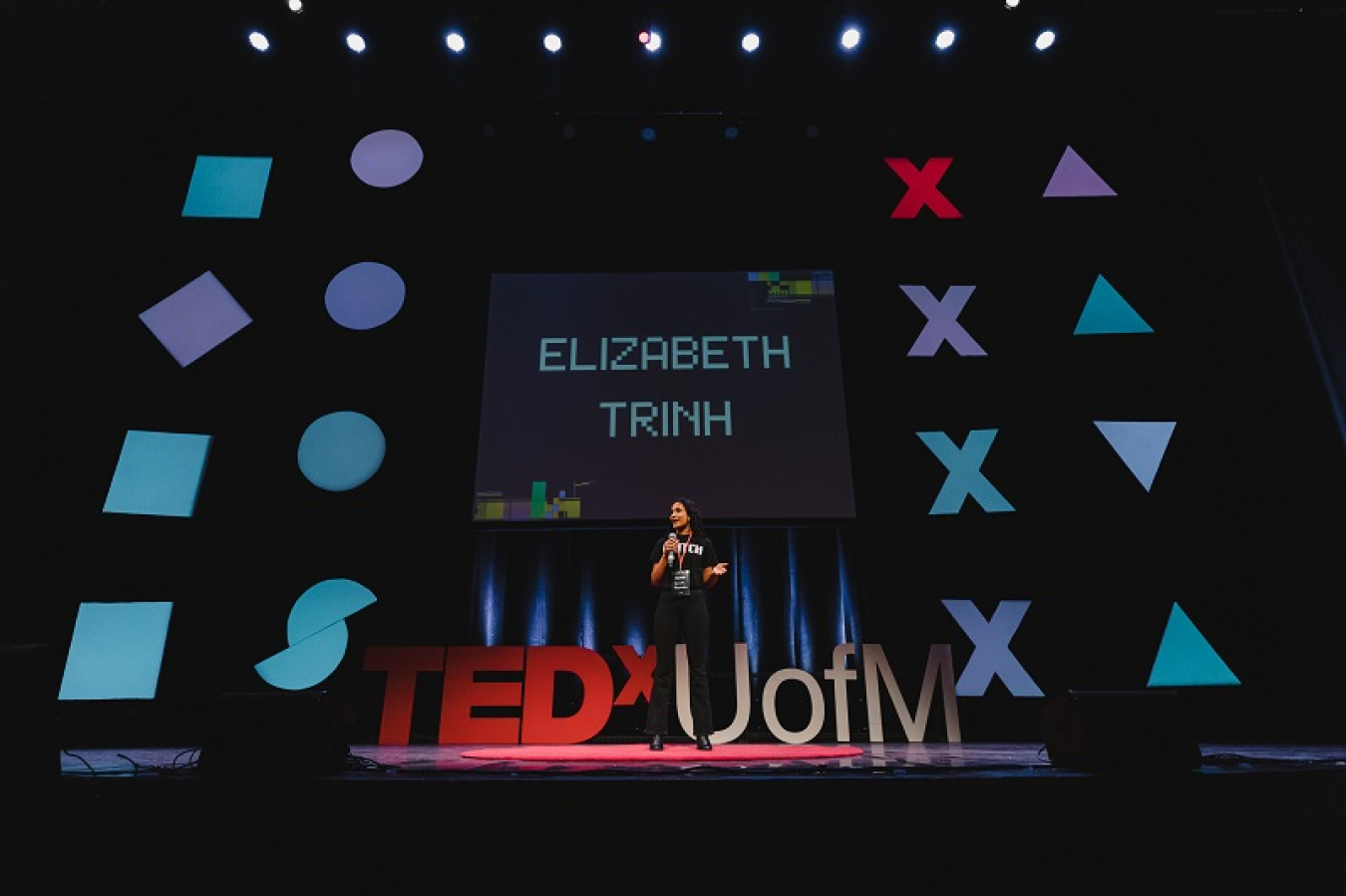Engineering students Jessica Beck and Samantha Jayasundera discuss how their shared passion for renewable energy and sustainable technology led them to create an award winning business plan to develop artificial kelp forests that could help generate clean energy.
Water Power Technologies Office
August 26, 2024In April 2024, two young women walked onto a stage in Austin, Texas, to accept an oversized check. Embodying an entrepreneurial ambiance, Jessica Beck and Samantha Jayasundera earned this $22,000 prize thanks to inspiration from a slimy, mud-colored algae called kelp. For about three months, the budding engineers had been refining a business plan for a technology that could mimic these squiggly ocean plants to generate clean energy, help restore ocean ecosystems, and protect coastal communities from natural disasters.
Ripple Effect
WPTO’s Ripple Effect series features individuals whose impactful work will help advance hydropower and marine energy technologies to achieve a clean energy future.
“Since natural disasters are becoming more and more prevalent as climate change worsens, we thought this was an important gap in the clean energy transition,” Beck said. “We need something that’s going to be reliable and provide power for coastal and island communities that are very isolated and have less immediate access to disaster relief."
Beck and Jayasundera called their company KelpNext. Their plan to sell artificial kelp forests earned them a bonus prize from the Water Power Technologies Office as part of the U.S. Department of Energy's EnergyTech University Prize. Through the prize, student teams develop a business plan for a promising energy technology that’s been created at a national lab or university and compete to earn part of the $400,000 prize pool.
But for both engineers, the competition was not just about building a successful business but also building a successful planet. Both see artificial kelp as just one potential solution for one of Earth’s biggest threats: climate change.
“Some people may feel deterred, like there’s no hope or there’s nothing you can do to solve it, which is a really common feeling nowadays—rightfully so,” Jayasundera said. “But anything can be impactful. It’s going to feel intimidating, but you have to start somewhere.”

-
How did both of you end up studying engineering?
Jessica: Around the beginning of high school, I had a mentor who was involved in environmental lobbying, sustainable agriculture, and food and plastic waste. She was very involved in the green spaces around our northwest suburb of Chicago and got me to join my school's environmental club. But I wanted to pursue something a little bit more technical, so I decided to study engineering. I've always been interested in how you can combine engineering and sustainability.
Samantha: I’ve been doing engineering my entire life. Sounds cheesy, but it’s true. When I was little, I would play with robots and build stuff, and then in middle school and high school, I was in science, mathematics, and computer science magnet programs. Both my parents are engineers, but high school was where I started doing environmental stuff. My senior year, I helped organize a conference in my county that focused, in part, on environmental protection.
How did you two meet?
Jessica: In a class called “Innovation for Impact: Climate Change.” Every student had a team and worked with a climate change startup in the carbon capture, utilization, and storage space. That’s where we met and found ourselves wanting to work on more projects related to renewable energy and sustainable technology.
Jessica, you’re a chemical engineering student with a minor in sustainability. And Samantha, you’re studying electrical engineering with a minor in entrepreneurship and specialization in sustainable engineering. Do your different specialties help make you a stronger team?
Jessica: I’d say yes. For this project, Samantha’s background in entrepreneurship really helped with creating and pitching a business proposal. And I brought other sustainability considerations when we were talking about how this would roll out and what kind of communities we could target.
Samantha: Our skills outside engineering helped a lot. We’re both strong presenters, and that helped us explain our ideas.

Tell us about KelpNext. How did you discover artificial kelp and marine energy?
Samantha: For the EnergyTech University Prize competition, a lot of teams come in with their own idea or startup, but another option is to partner with a lab. Jessie and I found that Nicole Mendoza, an aerospace engineer at the National Renewable Energy Laboratory, was working on a kelp-like marine energy device that could create electricity from its twisting and bending motions in the ocean. We converted that concept into KelpNext.
What problems could this technology help solve?
Samantha: This technology isn’t widely deployed right now, but it has so many applications and benefits. Its main purpose is to create electricity in a sustainable way, but it also helps trap nutrients and restore marine ecosystems. And, like real kelp, it can lessen the impact of waves on coastal communities. For example, if there’s a tsunami or intense storm, the kelp can help reduce potential flooding.
Jessica: It’s also not susceptible to storm damage in the way an aboveground structure would be. The artificial kelp resides under the surface of the water and isn't going to get wiped out, which means it could provide power in natural disasters when other sources of energy fail.
What excites you most about marine energy?
Samantha: Around 57% of the United States’ total electricity needs could be met from U.S. marine energy resources. Even harnessing just a small fraction of all available marine energy resources could make a big impact, especially since over 50% of the U.S. population lives within 50 miles of the coast. That speaks to how much of an impact marine energy can have in the United States if KelpNext or other marine energy technologies are deployed.
Did you face any unexpected challenges during the competition?
Jessica: Our ideas changed a lot from the initial submission to the final pitch. We started to learn what is realistic, and both of us were completely new to the idea of marine energy. I didn't even know the difference between this artificial kelp technology and a wave energy converter, which are wildly different. We learned a lot about microgrids and how you get something from a research lab scale to a commercialization scale.
Samantha: It was also challenging to be factual but also optimistic in our presentation to the judges. We revised our pitch so many times to show where the technology is right now but also how much it can become.

Jessica: And we’ve had to remind ourselves that we need to make sure people understand what this is and why it's impactful. We learned how to connect with people over super-important issues, like disaster relief and extreme weather preparedness, without getting too caught up in the weeds of the technology behind it.
Are you going to continue exploring this idea, or are you planning to branch off into other projects in the sustainable engineering world?
Samantha: Right now, we’re both busy, full-time students, so we don't feel like we have enough time to properly dedicate to develop this technology. But we’re planning to keep in touch with Nicole and are very excited to see where her artificial kelp technology goes.
Jessica: I would love to work in any role where sustainability is a primary focus, and I’m interested in the renewable energy space. Nicole gave us nice insight into what you can do in research, especially at the National Renewable Energy Laboratory.
Samantha: We’re so honored that Nicole trusted us to present this technology all the way up to the national level!

In an ideal world, what would you most hope to accomplish over the course of your careers?
Jessica: That has changed a lot even since I came to college. In general, I want to move the world to a more sustainable future that includes everybody. There are so many ways to do it, and I don’t want to pigeonhole myself. One thing I really loved about this project is it felt very forward-thinking, like we could make an impact on communities directly.
Samantha: I’m going to give an even more general answer: I want to have a positive impact on this Earth. If I can do that, then I think I’ll be happy.
What advice do you have for students who might want to solve some of these big world sustainability problems?
Samantha: I’m a big proponent for young people and change making. The team behind the EnergyTech University Prize clearly believes in the power of young people. So, believe in yourself, get together with other people who have the same ideals and values, and just start. For this competition, Jessie and I just found Nicole and her technology and slowly worked our way up. I don’t know if we could have said at the beginning that we would have ended up in Texas presenting our idea to these really cool judges.
Jessica: Small impacts really add up. Even something as small as a conversation with somebody about an issue—that kind of thing has a ripple effect. Our generation will be working on these problems in the future, so the more people that we have on board, the better.
Catch up on WPTO's other Ripple Effect profiles and the Office of Energy Efficiency and Renewable Energy's Clean Energy Champions.
And stay in the know with WPTO! Receive the latest information on funding opportunities, events, and other news by subscribing to the Hydro Headlines and Water Column newsletters, as well as the comprehensive Water Wire newsletter.

